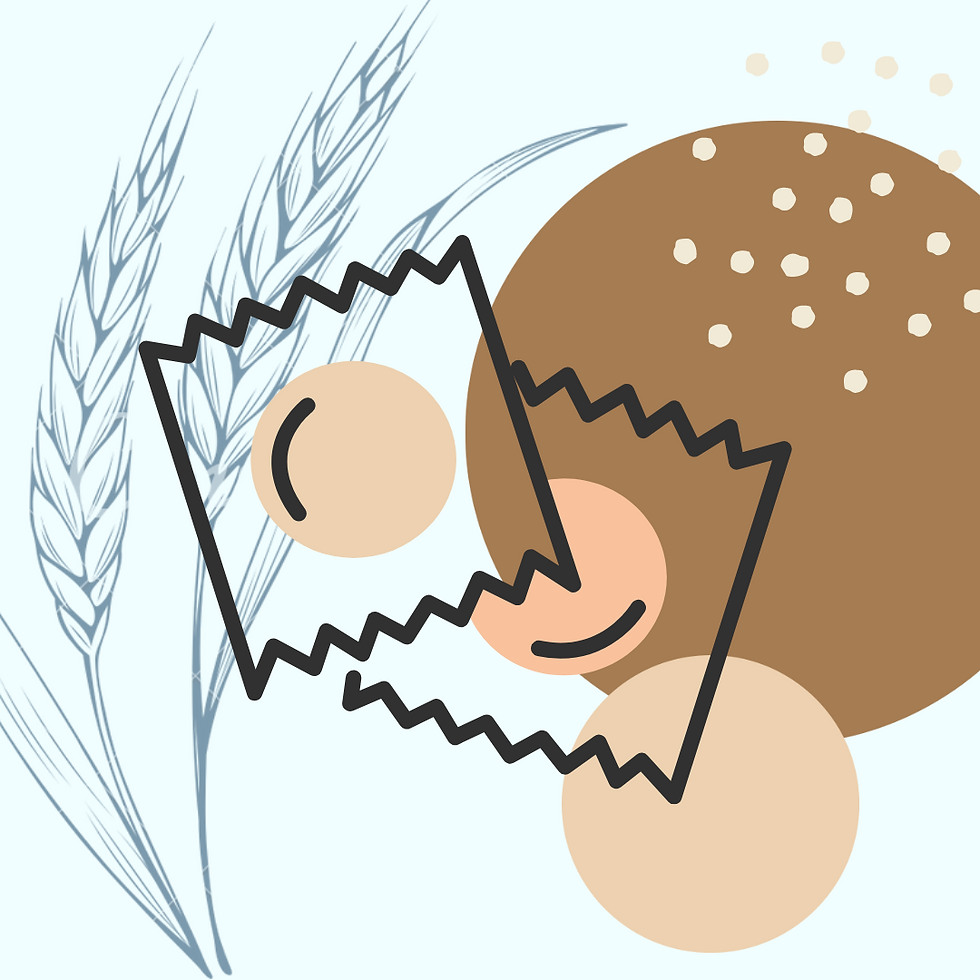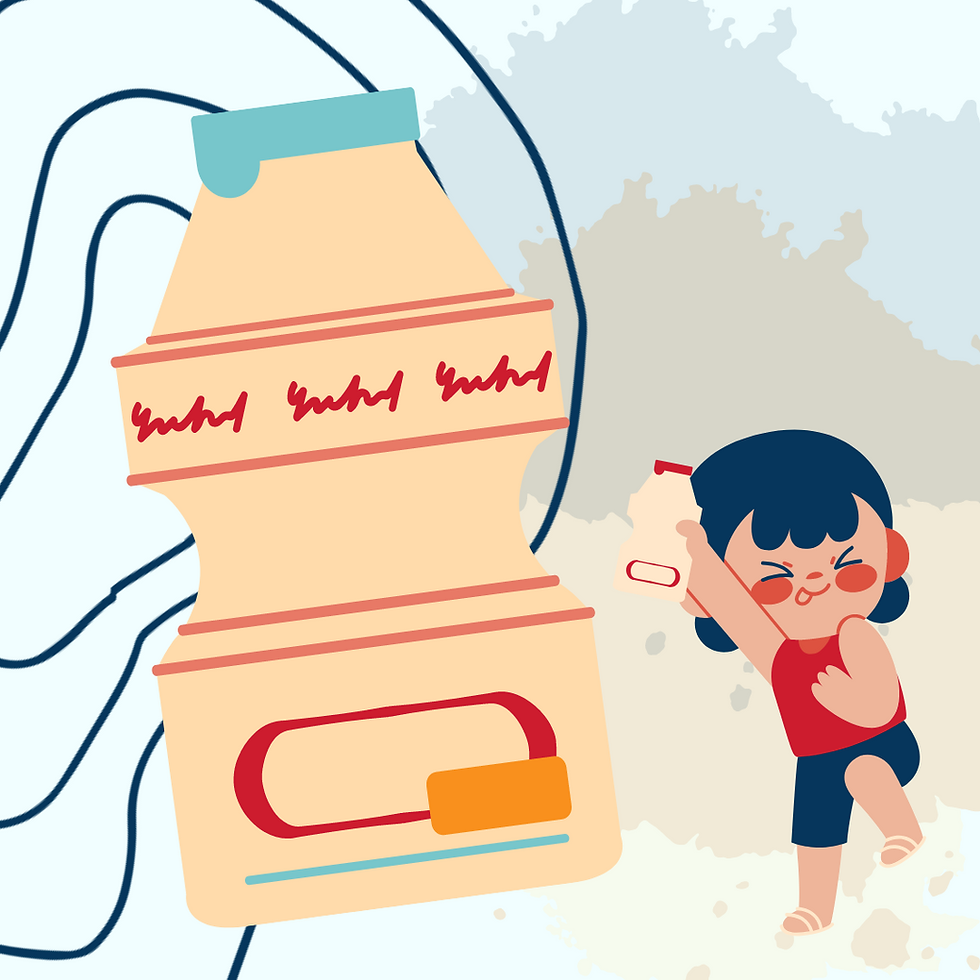Ingredients from store-bought commercial baking Yeast
- traceorgan
- Mar 22, 2022
- 5 min read
Updated: Sep 5, 2022

Ingredients: Yeast, Sorbitan Monostearate, Ascorbic Acid, Salt, Vitamin C, Iron*
Yeast
Purpose
Yeast is used as a leavening agent when baking (1).
Health Benefits
This fungus ferments sugars, releasing carbon dioxide (CO2) to make bread rise (2). Yeast has fibre that helps with digestion and slows the absorption of sugar, stabilizing blood sugar levels (3).
Potential Health Risks
Commercial yeast is not a problem for most people; however, too much fibre disrupts the digestive system and may cause stomach discomfort or bloating (3). Those with medical conditions, like Crohn's disease or allergies, and those who take medication should discuss with a health professional before consuming yeast, although the risks are highly unlikely.
Recommendation
Using yeast in baking won’t cause problems unless you have a medical condition that is affected by it.
Sorbitan Monostearate
Purpose
Sorbitan monostearate is added to yeast to provide moisture to the components of dough by rehydrating the yeast cells (4).
Health Benefits
Sorbitan monostearate is made from a combination of sorbitol, a naturally occurring sugar alcohol in various fruits and vegetables, and stearic acid, which is a saturated fatty acid found in animal or vegetable oils (5). This ingredient is used as an additive to mix the water and oils in many food products (5). It does not provide any specific health benefits.
Potential Health Risks
When consumed in excessive amounts, sorbitan monostearate can increase gastric motility (6). This means that food moves through the small intestine too quickly, and thus certain nutrients are not digested and absorbed. When those nutrients then move along to the large intestine, they can ferment, which can cause gastrointestinal discomfort, including symptoms of bloating, gas, and diarrhea (5).
Recommendation
The recommended intake for sorbitan monostearate is not more than 25 mg/kg body weight (4). The amount in yeast should cause no potential health risks.
Ascorbic Acid / Vitamin C
Purpose
Ascorbic acid, also known as vitamin C, is often added to food to give a citrusy flavour (7). It also acts as a preservative (7).
Health Benefits
Ascorbic acid is vital in the growth, development, and repair of body tissues (8).
It is especially involved in (8):
Formation of collagen
Absorption of iron
Proper functioning of the immune system
Wound healing
Maintenance of cartilage, bones, and teeth
Although the amount present in yeast has no health benefits, citrus fruits like oranges have more vitamin C for health benefits to show
Potential Health Risks
Consumers should not worry about the amount of vitamin C in food, but vitamin C supplements that have dangerous amounts which can get broken down into oxalate and can create kidney stones. A large amount of vitamin C, or ascorbic acid, can cause nausea, vomiting, heartburn, stomach cramps, and headaches by upsetting the stomach (9). (11). The amount in yeast should cause no potential health risks.
Recommendation
The recommended daily amount for ascorbic acid is 65 to 90 mg a day (11). Consuming too much may lead to moderate side effects. The amount in yeast should cause no potential health risks.
Salt
Purpose
Salt slows down the growth and reproduction of yeast, which prevents the dough from rising too quickly (12).
Health Benefits
A certain amount of salt is required by the body to control nerve impulses and muscles, as well as to maintain a balance of water and minerals within the body (13).
Potential Health Risks
A high salt intake can cause high blood pressure (14). The kidneys may have trouble removing excess salt to the point where the body cells start to contain more water due to osmosis, causing the volume of blood to increase and leading to high blood pressure, heart attacks, and strokes (13). High blood pressure can lead to aneurysms, which can lead to life-threatening internal bleeding (15). Overconsumption can also result in kidney damage by stiffening blood vessels, thereby hurting kidney function and leading to a build-up of water and waste in the body (16). Sexual dysfunction, stroke, heart attack and failure, kidney failure and disease, and vision loss are all complications from high blood pressure (15).
Recommendation
The amount of salt present in yeast should cause no significant health problems. It is recommended to have 1.5 grams for adults and 1 gram for children (16). Try not to go over 2.3 grams of salt as recommended by the American Heart Association (16). The amount of salt in yeast should cause no potential health risks.
Iron
Purpose
Iron is added for nutrients.
Health Benefits
Iron is required by red blood cells to carry oxygen from your lungs to the rest of your body (hemoglobin) (17). In addition, iron is required by muscle cells to accept, store, transport, and release oxygen (myoglobin) (17).
Potential Health Risks
An excessive amount of iron gradually causes it to build up in the tissues and organs, damaging the brain and liver (18). Iron overload can also be caused by a genetic disorder that prevents the body’s regulatory system from maintaining safe levels of iron in the body (18). This progressively increases body iron levels, heightening the risk of arthritis, cancer, liver problems, liver failure, heart failure, and/or diabetes (18).
Recommendation
In general, foods that naturally contain iron will have an adequate amount for the body. The amount of iron in yeast should cause no potential health risks.
Recommended intake of iron (per day) depending on age (19):
4-8: 10 mg
9-13: 8 mg
14-18 males: 11 mg | 14-18 females: 15 mg
19+ males : 8 mg
19 - 50 females: 18 mg (due to menstrual cycle)
51+ females: 8 mg
Overview: No harm when using
Commercial yeast is safe to consume in baked goods. Yeast serves its purpose well in baking, and there are little to no drawbacks to using it while baking.
References
Lindberg, S. (2019, September 19). What is the Difference Between Brewer’s Yeast & Baker’s Yeast. LIVESTRONG. https://www.livestrong.com/article/418496-what-is-the-difference-between-brewers-yeast-bakers-yeast/.
Pellegrinelli, C. (2019, November 16). What Is Yeast? The Spruce Eats. www.thespruceeats.com/basic-yeast-information-304312.
What Is Yeast and What Can It Do? WebMD. (2019, May 11). www.webmd.com/diet/ss/slideshow-yeast-and-your-body.
Han, J. (2020, May 15). What Is Sorbitan Monostearate (E491) in Food and Yeast? Uses and Safety. FOODADDITIVES. foodadditives.net/emulsifiers/sorbitan-monostearate/.
Sollid, K. (2019, April 18). What Is Sorbitol? Food Insight. foodinsight.org/what-is-sorbitol/.
National Center for Biotechnology Information (2021). PubChem Compound Summary for CID 13267937, Sorbitan monostearate. https://pubchem.ncbi.nlm.nih.gov/compound/Sorbitan-monostearate.
Chemical Safety Facts. (2020, May 7) Ascorbic Acid. ChemicalSafetyFacts.org. www.chemicalsafetyfacts.org/ascorbic-acid/.
Zelman, Kathleen M. (2020, September 12). Vitamin C Benefits, Sources, Supplements, & More. WebMD. www.webmd.com/diet/features/the-benefits-of-vitamin-c#1.
Elliott, B. (2019, December 13). Does Too Much Vitamin C Cause Side Effects? Healthline. healthline.com/nutrition/side-effects-of-too-much-vitamin-c.
Zeratsky, K. (2020, March 18). Is it possible to take too much vitamin C? Mayo Clinic. https://www.mayoclinic.org/healthy-lifestyle/nutrition-and-healthy-eating/expert-answers/vitamin-c/faq-20058030
Skerrett, Patrick J. (2013, February 5). High-Dose Vitamin C Linked to Kidney Stones in Men. Harvard Health Blog. www.health.harvard.edu/blog/high-dose-vitamin-c-linked-to-kidney-stones-in-men-201302055854.
Luchian, M. I., & Canja, C. M. Effect of Salt on Gas Production in Bread Dough. ResearchGate. https://www.researchgate.net/publication/268198063_EFFECT_OF_SALT_ON_GAS_PRODUCTION_IN_BREAD_DOUGH
Harvard Chan SPH. (2020, October 19). Salt and Sodium. The Nutrition Source. www.hsph.harvard.edu/nutritionsource/salt-and-sodium/.
Palsdottir, H. (2017, June 18) Salt: Good or Bad? Healthline. www.healthline.com/nutrition/salt-good-or-bad.
Mayo Clinic Staff. (2019, November 19). High blood pressure dangers: Hypertension’s effects on your body. Mayo Clinic. https://www.mayoclinic.org/diseases-conditions/high-blood-pressure/in-depth/high-blood-pressure/art-20045868.
American Heart Association. (2018, May 23). How Much Sodium Should I Eat per Day? heart.org. www.heart.org/en/healthy-living/healthy-eating/eat-smart/sodium/how-much-sodium-should-i-eat-per-day.
UCSF Health. (2020, October 6). Hemoglobin and Functions of Iron. Ucsfhealth.org. www.ucsfhealth.org/education/hemoglobin-and-functions-of-iron.
Arnarson, A. (2017, June 4). The Dark Side of Iron - Why Too Much Is Harmful. Healthline. www.healthline.com/nutrition/why-too-much-iron-is-harmful.
Wartenberg, L. (2019, December 9). How Much Iron Do You Need per Day? Healthline. www.healthline.com/nutrition/how-much-iron-per-day#recommendations.
Credits:
Researcher: Ethan Ma, Ishvita, Arthur, Aarush
Reviewed by: Karen Giesbrecht (Registered Dietitian)
Editor: Tanya and Ethan Ma
Graphics: Tiffany Z
Last updated on March 22nd, 2022, 8:12 PM PST/PDT
*Disclaimer: Ingredients may vary from company to company and product to product. The information included is for educational purposes only and is not intended to be a substitute for medical treatment by a healthcare professional. Because of unique individual needs, please consult a registered dietitian for nutrition recommendations that are customized for you.
.png)




Comments